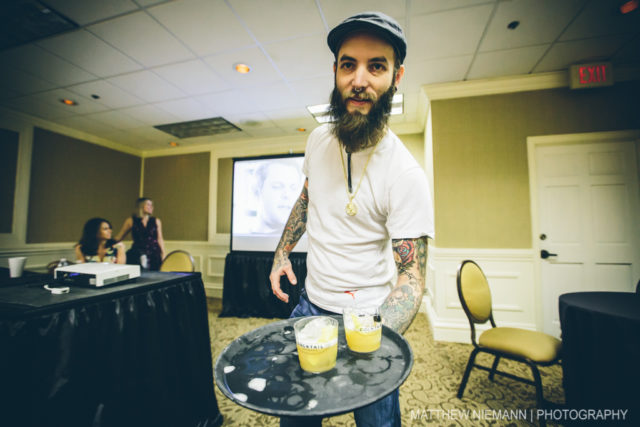An iconic cocktail transcends place and time. You know the list of the usual suspects: Manhattan, Old Fashioned, Bees Knees, Singapore Sling, Cosmopolitan and Penicillin. These are the kinds of drinks that have staying power and ultimately become iconic.
But what is an iconic cocktail? Industry insider Claire Bertin-Lang defined it at the 2016 San Antonio Cocktail Conference as one that is “consistently made the same way using similar ingredients and recipe and called by the same name.”

These classic cocktails jump across regions, countries and oceans to become world renown, and are often attributed to a person or place. And for all you bartenders—or amateurs—looking to create your own iconic cocktail, Bertin-Lang had a three key elements.
1. Accessible Ingredients
Her first rule is that the ingredients should be widely available. An Old Fashioned is just whiskey, citrus, honey and bitters. A Cosmopolitan is citrus vodka, Cointreau or Triple Sec, cranberry juice and lime. Having accessible ingredients means that anyone can have the means to reproduce your cocktail, enabling it to go big.
“If you have some obscure bitters that you only make in your basement and that’s an essential ingredient to your cocktail, you’re cocktail’s not going to become iconic because not everybody can get that ingredient,” Bertin-Lang cautions.
Find out one of Claire’s favorite iconic cocktails in the video below!
2. Simple To Make
While it may be enjoyable to combine a multitude of ingredients together in a cocktail at home, when a bar gets jumpin’ nobody has time for a drink that has a litany of ingredients that must be put together with scientific precision. You got to get the people served!
So if you want your cocktail to make it big, leave all multi-step processes at home and remember the KISS principle: Keep It Simple, Stupid. “If you have 18 ingredients in a cocktail it’s probably not going to become iconic,” Bertin-Lang says. “It’s just too much of a pain in the ass.”
(Ironically, however, is that the Singapore Sling with it’s crazy recipe somehow defies this guideline, but it’s the exception not the rule.)
https://www.instagram.com/p/BAm_l6yHYuB/
3. Catchy Name
A rose by any other name may still be a rose, but a cocktail with a ridiculous name has a one-way ticket to obscurity. All classic cocktails have that name, that identity that just makes it sound awesome. And if you suck at creating names, tie the cocktails identity to the place where it was created. But whatever you do, don’t call it something that would make the customer feel ridiculous or embarrassed for saying out loud.
“‘Whispers of Clouds’ will never be classic, iconic cocktail. It just won’t, it doesn’t sound cool,” says Pamela Wiznitzer, Creative Director of Seamstress an Upper Eastside cocktail bar in NYC.
Making the Leap to Iconic Cocktail
Just because your cocktail has those three elements doesn’t mean that it’s going to become world-famous overnight. These other factors can help you create that iconic cocktail:
- Tastes Good — let’s be honest, if it tastes like turpentine nobody will buy it
- Look Different — take advantage of any way to make your cocktail “look” different; part of the allure of the Grasshopper is that green color
- Platform/Venue — having the right stage can go a long way, find a well-known bar instead of a dive bar in Sheboygan
- Attribution — be sure to find a way to document your efforts, whether it’s on your bar’s website or your own personal blog
- Backed by a Brand — reach out to the brand rep of the spirit you used for help with publicity; they have a vested interest in helping create demand for their product
- Travel/Network — get outta town, literally, and attend conferences and industry events to connect, collaborate and share your innovation with others
Reinterpreting Classics
Rather than creating something new, there could be the opportunity to reinterpret a classic with your own spin. Bertin-Lang said that bartenders such as Sasha Petraske found a way to play around with the proportions of the ingredients of an classic cocktails. However, even though they may change the ratios, Petraske’s version of a Mojito is still a Mojito.
She pointed to the Amaretto Sour that was created by Portland-based bartender Jeffery Morgenthaler. He found the original recipe to be a little too sweet and weak because the Amaretto lacked the alcohol content to stand up to other ingredients. So he decided to add a little cask-strength Bourbon to the mix and created his version of the classic.

A Little Bit of Luck Can’t Hurt
Let’s be honest though, when it comes to creating a cocktail that’s going to be remembered decades from now, a little bit of luck can’t hurt. But Bertin-Lang definitely laid out some best practices that you should consider following in your pursuit. Did you create an amazing cocktail? Be sure to let me know about it in the comments and where I can get it—bonus points if you leave the recipe.
Cheers to all the bartenders out there who are creating the next great thing. Just remember, don’t call it Whispers of Clouds.
This was one of two classes that I took at the 2016 San Antonio Cocktail Conference and once again I was impressed by the quality. It doesn’t matter whether you are a bartender or an amateur, if you love cocktails and spirits you don’t want to miss this event!
Sign up for the SA Flavor Newsletter for all the best of SA without the spam! And be sure to shop the SA Flavor Store for the best Fiesta Medals, stickers, shirts and more!